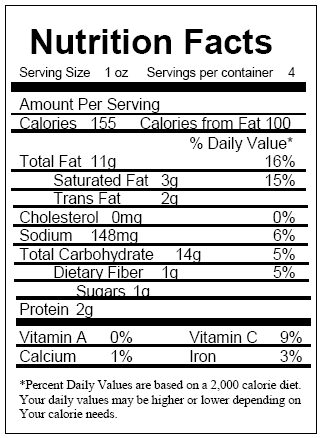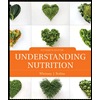The purpose of this assignment is to understand processes within organ systems and organisms that control the body to maintain homeostasis. After completing the Unit 4 Lab on Connect (above), apply critical thinking to answer the following: 1. Plaque Formation in Arteries: High levels of LDL cholesterol in the bloodstream can lead to formation of “plaques” in the arteries. • What are the potential health consequences of coronary arteries being clogged by “plaques”? • Name some specific foods that might lead to increased LDL cholesterol in the bloodstream. • What do these foods contain that could cause this? 2. Nutrition Labels: Analyze the nutrition label attached and answer the following questions: • How much total fat, saturated fat and trans fat does this product contain per serving? • How many grams of total fat would a person consume if he/she ate the whole container? • How many calories are from fat per serving? • Calculate the percentage of the total calories per serving that come from total fat. • Based on a 2,000 calorie diet, what percent of the percent daily value for total fat would be consumed per serving? Calculate the percent if the whole container was consumed. • Based on what you know about trans fats, do you think there are hydrogenated oils in this product? Explain. Upload your answers in a Word document.
The purpose of this assignment is to understand processes within organ systems and organisms that control the body to maintain homeostasis. After completing the Unit 4 Lab on Connect (above), apply critical thinking to answer the following: 1. Plaque Formation in Arteries: High levels of LDL cholesterol in the bloodstream can lead to formation of “plaques” in the arteries. • What are the potential health consequences of coronary arteries being clogged by “plaques”? • Name some specific foods that might lead to increased LDL cholesterol in the bloodstream. • What do these foods contain that could cause this? 2. Nutrition Labels: Analyze the nutrition label attached and answer the following questions: • How much total fat, saturated fat and trans fat does this product contain per serving? • How many grams of total fat would a person consume if he/she ate the whole container? • How many calories are from fat per serving? • Calculate the percentage of the total calories per serving that come from total fat. • Based on a 2,000 calorie diet, what percent of the percent daily value for total fat would be consumed per serving? Calculate the percent if the whole container was consumed. • Based on what you know about trans fats, do you think there are hydrogenated oils in this product? Explain. Upload your answers in a Word document.
Chapter19: Nutrition
Section: Chapter Questions
Problem 3ATP
Related questions
Question
The purpose of this assignment is to understand processes within organ systems and organisms that control the body to maintain homeostasis.
After completing the Unit 4 Lab on Connect (above), apply critical thinking to answer the following:
1. Plaque Formation in Arteries: High levels of LDL cholesterol in the bloodstream can lead to formation of “plaques” in the arteries.
• What are the potential health consequences of coronary arteries being clogged by “plaques”?
• Name some specific foods that might lead to increased LDL cholesterol in the bloodstream.
• What do these foods contain that could cause this?
2. Nutrition Labels: Analyze the nutrition label attached and answer the following questions:
• How much total fat, saturated fat and trans fat does this product contain per serving?
• How many grams of total fat would a person consume if he/she ate the whole container?
• How many calories are from fat per serving?
• Calculate the percentage of the total calories per serving that come from total fat.
• Based on a 2,000 calorie diet, what percent of the percent daily value for total fat would be consumed per serving? Calculate the percent if the whole container was consumed.
• Based on what you know about trans fats, do you think there are hydrogenated oils in this product? Explain.
After completing the Unit 4 Lab on Connect (above), apply critical thinking to answer the following:
1. Plaque Formation in Arteries: High levels of LDL cholesterol in the bloodstream can lead to formation of “plaques” in the arteries.
• What are the potential health consequences of coronary arteries being clogged by “plaques”?
• Name some specific foods that might lead to increased LDL cholesterol in the bloodstream.
• What do these foods contain that could cause this?
2. Nutrition Labels: Analyze the nutrition label attached and answer the following questions:
• How much total fat, saturated fat and trans fat does this product contain per serving?
• How many grams of total fat would a person consume if he/she ate the whole container?
• How many calories are from fat per serving?
• Calculate the percentage of the total calories per serving that come from total fat.
• Based on a 2,000 calorie diet, what percent of the percent daily value for total fat would be consumed per serving? Calculate the percent if the whole container was consumed.
• Based on what you know about trans fats, do you think there are hydrogenated oils in this product? Explain.
Upload your answers in a Word document.

Transcribed Image Text:Nutrition Facts
Serving Size 1 oz Servings per container 4
Amount Per Serving
Calories 155 Calories from Fat 100
Total Fat 11g
Saturated Fat 3g
Trans Fat
2q
Cholesterol 0mg
Sodium 148mg
Total Carbohydrate
Dietary Fiber 1g
Sugars 10
Protein 2g
Vitamin A 0%
Calcium 1%
% Daily Value*
16%
15%
14g
Vitamin C
Iron
0%
6%
5%
5%
9%
3%
*Percent Daily Values are based on a 2,000 calorie diet.
Your daily values may be higher or lower depending on
Your calorie needs.
Expert Solution
This question has been solved!
Explore an expertly crafted, step-by-step solution for a thorough understanding of key concepts.
Step by step
Solved in 3 steps

Follow-up Questions
Read through expert solutions to related follow-up questions below.
Follow-up Question
Based on a 2,000 calorie diet, what percent of the percent daily value for total fat would be consumed per serving? Calculate the percent if the whole container was consumed.
Solution
Knowledge Booster
Learn more about
Need a deep-dive on the concept behind this application? Look no further. Learn more about this topic, biology and related others by exploring similar questions and additional content below.Recommended textbooks for you


Understanding Nutrition (MindTap Course List)
Health & Nutrition
ISBN:
9781337392693
Author:
Eleanor Noss Whitney, Sharon Rady Rolfes
Publisher:
Cengage Learning



Understanding Nutrition (MindTap Course List)
Health & Nutrition
ISBN:
9781337392693
Author:
Eleanor Noss Whitney, Sharon Rady Rolfes
Publisher:
Cengage Learning


Health Safety And Nutrition F/Young Child
Health & Nutrition
ISBN:
9781305144767
Author:
MAROTZ
Publisher:
Cengage

Nutrition
Health & Nutrition
ISBN:
9781337906371
Author:
Sizer, Frances Sienkiewicz., WHITNEY, Ellie
Publisher:
Cengage Learning,
